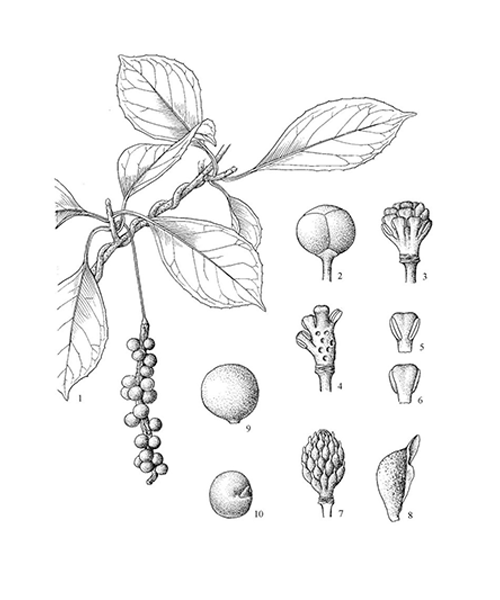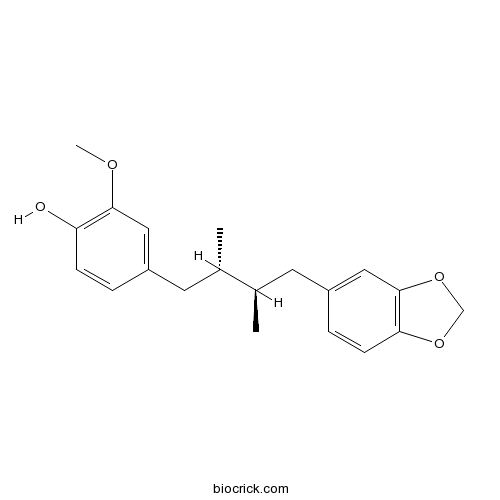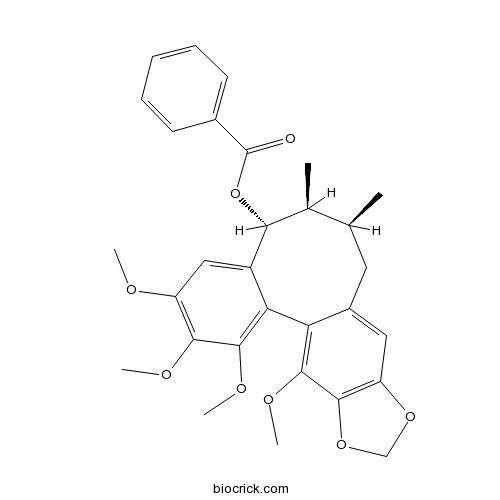Schisandra sphenanthera
Schisandra sphenanthera
1. The products in our compound library are selected from thousands of unique natural products; 2. It has the characteristics of diverse structure, diverse sources and wide coverage of activities; 3. Provide information on the activity of products from major journals, patents and research reports around the world, providing theoretical direction and research basis for further research and screening; 4. Free combination according to the type, source, target and disease of natural product; 5. The compound powder is placed in a covered tube and then discharged into a 10 x 10 cryostat; 6. Transport in ice pack or dry ice pack. Please store it at -20 °C as soon as possible after receiving the product, and use it as soon as possible after opening.

Natural products/compounds from Schisandra sphenanthera
- Cat.No. Product Name CAS Number COA
-
BCN5362
Anwulignan107534-93-0
Instructions

-
BCN3092
6-O-benzoylgomisin O130783-32-3
Instructions

-
BCN2508
Schisanhenol69363-14-0
Instructions

Sustainable harvest, people and pandas: Assessing a decade of managed wild harvest and trade in Schisandra sphenanthera.[Pubmed: 29883683]
Endemic to China, the distribution of Schisandra sphenanthera Rehder & E.H. Wilson includes giant panda (Ailuropoda melanoleuca David, 1869) habitats in forests of the Minshan and Qinling Mountains, both inside and outside conservation areas. The fruit is used in indigenous medicines of the Qiang, Tibetan and Yi ethnic minorities of Sichuan. Also used in traditional Chinese medicine (TCM), indications for use are prescribed in the Chinese Pharmacopoeia. For continued access and medical use, survival of healthy populations depends on forests. Biodiversity conservation programmes implemented in forests within the panda landscapes that also benefit rural and indigenous communities, link future access to wild medicinal plants with survival of the panda and resilient rural economies.
Schisantherin A protects renal tubular epithelial cells from hypoxia/reoxygenation injury through the activation of PI3K/Akt signaling pathway.[Pubmed: 29785781]
Schisantherin A (SchA), a dibenzocyclooctadiene lignan isolated from the fruit of Schisandra sphenanthera, was reported to possess anti-inflammatory and antioxidant activities. However, its protective effect against renal ischemia-reperfusion (I/R) injury in human renal tubular epithelial cells subjected to hypoxia/reoxygenation (H/R) has never been studied. Thus, herein, we investigated the effect of SchA on renal I/R injury in vitro. Our results demonstrated that SchA pretreatment significantly improved HK-2 cell viability exposed to H/R. Pretreatment with SchA markedly inhibited the levels of reactive oxygen species and malondialdehyde, as well as suppressed the production of tumor necrosis factor-α (TNF-α), interleukin-1β, and interleukin-6 in H/R-stimulated HK-2 cells. In addition, SchA also suppressed H/R-induced HK-2 cell apoptosis. Furthermore, this protective effect of SchA was mediated through the PI3K/Akt signaling pathway in HK-2 cells. These findings showed that SchA may exert a protective effect on renal tubular epithelial cells against H/R injury through the activation of PI3K/Akt signaling pathway.
Characteristics and Antioxidant Activity of Lignans in Schisandra chinensis and Schisandra sphenanthera from Different Locations.[Pubmed: 29706012]
Twenty Schisandra samples were collected from different locations. Contents of 7 lignans in the samples were determined and analyzed by HPLC method coupled with hierarchical clustering analysis (HCA) and principal component analysis (PCA), and the antioxidant capacity of Schisandra from the different locations was evaluated by reducing power, ferric thiocyanate (FTC) and 2,2'-diphenyl-1-picrylhydrazyl (DPPH) assay. The results showed that there was a significant difference in the content of lignans between Schisandra chinensis and Schisandra sphenanthera. The Schisandra sphenanthera samples in the southwest of China were significantly different from those from the other locations. The antioxidant capacity of Schisandra chinensis was significantly superior to that of Schisandra sphenanthera, and the main antioxidant components were schisandrol A, schisandrol B and schisandrin B based on the result of discrimination analyses. The differences in the chemical composition and antioxidant activity of lignans in Schisandra chinensis and Schisandra sphenanthera from the different locations were investigated in this study, which may provide an experimental basis for the quality control of Schisandra.
A review of polysaccharides from Schisandra chinensis and Schisandra sphenanthera: Properties, functions and applications.[Pubmed: 29352909]
Schisandra is an herbal plant resource with dual functions in medicine and food since ancient times. It has a variety of healthcare and therapeutic effects. Schisandra chinensis (Turcz.) Baill and Schisandra sphenanthera Rehd. et Wits are two of the most commonly used Schisandra. Traditional Chinese medicine experience has shown that water-soluble polysaccharide from Schisandra may be one of its main components with pharmacological effects. Progress in the industrial production and extraction process of plant polysaccharides, especially Chinese medicine polysaccharides in the past three decades, have led to many new discoveries about Schisandra polysaccharides in the fields of purification and identification. Their health benefits and pharmacological value have increased the interest of the public and academia. This review summarizes the physicochemical properties and biological functions of polysaccharides from two Schisandra fruits, and the application prospects of these bioactive macromolecules in future daily life and medicine.
Schisandrol B promotes liver regeneration after partial hepatectomy in mice.[Pubmed: 29066412]
Liver regeneration is a vital process of recovery after liver damage, which is a promising clinical strategy after partial hepatectomy (PHx). Schisandrol B (SolB), one of the bioactive ingredients from Schisandra sphenanthera, displays significant hepato-protection effects against drug-induced liver injure in mice. However, the effect of SolB on liver regeneration after PHx remains unclear. Here, we showed that SolB treatment promoted liver mass restoration and increased the number of proliferative hepatocytes following PHx. SolB treatment significantly improved the levels of growth factors (HGF and EGF) and cytokines (IL-6), which further activated STAT3/Akt/MAPK signaling pathways and induced the expression of several the protein of cell cycle core. Overall, this study is the first to demonstrate the role of SolB in promoting liver regeneration during PHx challenge, which provide a clinically relevant argument for using SolB to facilitate liver recovery after undergoing PHx or liver transplantation.


